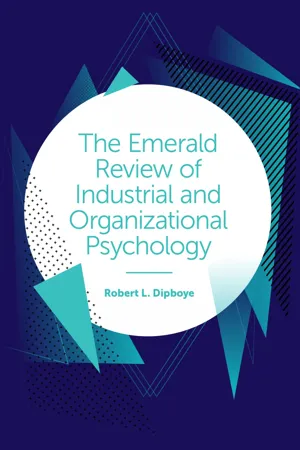Business
How to Measure Job Satisfaction
Measuring job satisfaction involves assessing employees' feelings and attitudes towards their work and the workplace. Common methods include surveys, interviews, and observation to gather data on factors such as pay, benefits, work environment, and relationships with colleagues and supervisors. Analyzing this information can help organizations identify areas for improvement and develop strategies to enhance employee satisfaction.
Written by Perlego with AI-assistance
Related key terms
Related key terms
1 of 4
Related key terms
1 of 3
9 Key excerpts on "How to Measure Job Satisfaction"
- eBook - ePub
Organizational Psychology
A Scientist-Practitioner Approach
- Steve M. Jex, Thomas W. Britt(Authors)
- 2014(Publication Date)
- Wiley(Publisher)
Finally, a measure of job satisfaction included in a longer assessment of organizational perceptions and attitudes is the job satisfaction subscale of the Michigan Organizational Assessment Questionnaire (Cammann, Fichman, Jenkins, & Klesh, 1983). This is an overall measure of job satisfaction that includes only three items: (1) All in all, I am satisfied with my job, (2) In general, I don't like my job, and (3) In general, I like working here. Bowling and Hammond (2008) conducted a meta-analysis of 79 relationships between the job satisfaction measure and theoretically related variables, and found that the measure demonstrated appropriate correlations with related constructs such as work stressors and organizational perceptions (e.g., perceptions of justice in the workplace and doing significant work).In conclusion, a number of valid measures exist to measure overall job satisfaction and satisfaction with different aspects of one's job. The normative information on many of these scales is especially useful for organizational psychologists who want to be able to compare their employees to employees from similar occupations and organizations. Now that we have addressed the prediction and measurement of job satisfaction, we address the important question of outcomes predicted by job satisfaction.Predictors of Job Satisfaction
A substantial portion of the research conducted on job satisfaction over the years has been devoted to explaining what exactly determines employees' levels of job satisfaction. Understanding the development of job satisfaction is certainly of theoretical importance to organizational psychologists. It is also of practical interest to organizations as they attempt to influence employees' levels of job satisfaction and, ultimately, other important outcomes.There are three general approaches to explaining the development of job satisfaction: (1) job characteristics, (2) social information processing, and (3) dispositional - Elizabeth George, Zakkariya K.A.(Authors)
- 2018(Publication Date)
- Palgrave Pivot(Publisher)
1980 ).Job satisfaction is how people feel about their jobs and different aspects of their jobs (Spector 1997 ).Job satisfaction is one’s emotional response to a job that results from the person’s expectations of the job and the reality of the job situation (Hsiao and Kohnke 1998 ).Job satisfaction as a general attitude towards one’s job; the difference between the amount workers receive and the amount they believe they should receive (Robbins 1998 ).Job satisfaction represents the workplace and employees’ perceptions of their job. Job satisfaction can be envisaged by levels of support an employee gets from his organization, the employment situation and employees’ evaluation of the work climate in the organization (Susskind et al. 2000 ).Employees will be motivated to perform their jobs, when they consider their jobs as meaningful and enjoyable. The nature of job satisfaction is such that an employee would tend to stay with a job which is satisfying him and quit a job which is dissatisfying him.4.1.2 Models and Theories of Job Satisfaction
Herzberg et al. (1959 ) clearly explain a two-dimensional paradigm of factors affecting work attitudes that can be regarded as a theory base for job satisfaction . They emphasize the factors characterizing events on the job that lead to extreme job satisfaction (intrinsic factors) and those that lead to extreme dissatisfaction (extrinsic factors). Motivating or intrinsic factors refer to factors that stem from performing the work and from experiencing feeling of accomplishment like achievement, recognition, responsibility, and advancement. These factors are considered as strong determinants of job satisfaction- eBook - ePub
The Psychology of Behaviour at Work
The Individual in the Organization
- Adrian Furnham(Author)
- 2012(Publication Date)
- Psychology Press(Publisher)
Social learning appears to be a means by which people develop attitudes, not only in work settings but also in other social situations. However, not everyone is equally likely to model the behaviour of others, nor is everyone equally likely to serve as a model. Consequently, social learning is apt to be a better explanation for job satisfaction and other attitudes in certain situations, and for certain people than for others. Essentially, social learning theory traditionally sees individual differences as error variance. However, there is no reason to deny that there are individual differences in the extent to which people are likely to be influenced by the ideas, beliefs and behaviours of those around them. Personality differences are not incompatible with social factors operating (Furnham, 1992: 210–211).Measuring job satisfactionIt is possible to measure job satisfaction in various ways: by standard questionnaire, group or individual interviews, exit interviews as well as overt behaviours. Questionnaire measures of job satisfaction are of two kinds: general (overall) and specific. The former simply attempt to ascertain general overall satisfaction with the “total package” that is the job. There are many questionnaires that attempt to do this, dating back over 50 years. There are also dimensions or facet-specific measures which attempt to assess satisfaction with quite different features of the job, such that one is able to ascertain precise measures of different things such as satisfaction with pay, supervisory style, physical conditions, and so on.The Brayfield & Rothe (1951) index is a frequently used measure, aptly titled the “overall job satisfaction” measure (Box 6.4 ). Another example of this approach is the extensively used Minnesota Satisfaction Questionnaire (Weiss, Davis, England, Lofquist, 1967). The scale purports to measure intrinsic (I) and extrinsic (E) motivation in different areas but yields an overall satisfaction score (Box 6.5 ).An example of the multifaceted test can be found in the much more complex “index of organizational reactions” devised by Smith (1976). This scale yields scores on various satisfaction scales such as supervision, nature of work, amount of work, working conditions, co-workers, pay, the future of the organization, and overall job satisfaction (Box 6.6 - eBook - ePub
Interdisciplinary Research in Technology and Management
Proceedings of the International Conference on Interdisciplinary Research in Technology and Management (IRTM, 2022), 24-26th February 2022, Kolkata, India
- Satyajit Chakrabarti, Ashiq A. Sakib, Rohit Singh, Pradipta Kumar Banerji, Sanghamitra Poddar, Anupam Bhattacharya, Malay Gangopadhyaya, Srijita Chakraborty, Satyajit Chakrabarti, Ashiq A. Sakib, Rohit Singh, Pradipta Kumar Banerji, Sanghamitra Poddar, Anupam Bhattacharya, Malay Gangopadhyaya, Srijita Chakraborty(Authors)
- 2023(Publication Date)
- CRC Press(Publisher)
Neupane [ 36 ] observed that job satisfaction is mainly dependent on some variables. The basic dependent variables are the working environment, cooperation between employees, salary, training, and promotion. These variables satisfied the employees with 64.1 % and the rest of the variables satisfied up to 35.9 %. Dziuba et Al. [ 37 ] explored that cheerful and satisfied employee perform their duties efficiently become more responsible and feel themselves an important part of an organization. Measures of Employees Performance Kelidbar. et al. [ 38 ] found in their studies, employee job performance has always been the main concern for employers of organizations. Likewise, employee performance is a key structure of an organization and the main place for high performance and it must be scrutinized critically by the organizations for them to succeed (Abbas and Yaqoob, [ 39 ]). Further, Lee et al. [ 40 ], explained that the effects of internal marketing, job satisfaction and service attitude on job performance among high-tech have always been regarded as an important item in organizational management. The authors defined, job performance as workers’ total performance in meeting the anticipated worth and achievement of tasks under the process and time constraints of the organization. Likewise, Liao et al. [ 41 ] explained job performance as the standard for improvements, termination, rewards, punishments, reviews and salary changes. It also satisfies the requirements for employees to realize themselves - Robert L. Dipboye(Author)
- 2018(Publication Date)
- Emerald Publishing Limited(Publisher)
Although the use of one-item attitude measures continues to dominate national surveys, psychologists have attempted to deal with the potential problems by using self-report measures of attitudes toward specific facets of the job. In job satisfaction questionnaires, it is common to ask about facets such as the pay, one’s supervisor, one’s coworkers, the working conditions, the job itself, benefits, and other characteristics of the work and the work context. It is also common to include an overall job attitude measure consisting of the average of responses to the ratings of the separate facets. To illustrate, I will consider four multi-facet job satisfaction questionnaires: the Hoppock job satisfaction scale, the Faces scale, the Job Description Index (JDI), and the Minnesota Satisfaction Questionnaire (MSQ). While not exhausting the possibilities, they provide examples of some of the alternatives to measuring job satisfaction. The Hoppock Scale of Job Satisfaction. The true beginning of scientific, quantitative research on job satisfaction was in the 1930s with Robert Hoppock who was a graduate student interested in applying newly developed scaling (measurement) techniques to the study of job satisfaction. He posed questions to residents of his home town, who answered on a scale ranging from 100 (extreme dissatisfaction) to 700 (extreme satisfaction). Although this seems like a common and simple task, collecting such data was a novel concept in the 1930s. With the aid of his father-in-law, he collected data from most working adults in New Hope, Pennsylvania. Hoppock found approximately 88% of those sampled to be satisfied with their jobs. He also found the most satisfied workers were in the professional, managerial, and executive occupations (Hoppock, 1935). Although job satisfaction is highest among the most prestigious occupations and lowest among the least prestigious, there is considerable overlap, with many laborers as satisfied as many professionals- Colin P. Silverthorne(Author)
- 2005(Publication Date)
- NYU Press(Publisher)
10Job Satisfaction and Organizational Commitment Motivation and performance are influenced by the emotions we experience both at work and in our personal lives. How our attitudes and emotions affect our behavior is explored in this chapter.Job Satisfaction
The very extensive literature concerning job satisfaction indicates that, across a variety of work settings, job satisfaction is an important workplace construct that is of concern for effective management. Job satisfaction is defined as “a pleasurable or positive emotional state resulting from the appraisal of one’s job” (including various facets of that job). Job satisfaction can be broken down into three general areas: the values that an individual has or wants, the perception of how the organization meets these values, and their relative importance to the individual (Locke, 1976). Job satisfaction has been linked to positive workplace outcomes such as increased organizational commitment, with workers having high levels of job satisfaction being more likely to be committed to the organization (Brown and Peterson, 1994). Furthermore, individuals with higher levels of job satisfaction are less likely to seek out a different job (Sager, 1994) or to leave the organization (Boles, Johnson, and Hair, 1997). Employee job satisfaction is also a function of intrinsic and extrinsic rewards offered by a job (Tuch and Martin, 1991), status associated with job level (Cox and Nkomo, 1991), and work values (Drummond and Stoddard, 1991). Furthermore, task, status, monetary reward, and social relationships (or a team dimension) are four essential aspects of job satisfaction (Neil and Snizek, 1987) and are also important dimensions of work values (Shuka, Sarna, and Nigam, 1989). They are the basis of the reward thesis, which explains higher job satisfaction by the intrinsic and extrinsic rewards obtained from a promotion (Wright, Bengtsson, and Frankenberg, 1994). As mentioned earlier, turnover is a major issue for many organizations and is very important to control because of the costs associated with hiring and training new personnel, as well as the costs associated with not having that individual contributing his or her work efforts toward organizational goals. Creating and maintaining a high level of job satisfaction is one of the most important attitudinal issues faced by managers in the workplace.- eBook - ePub
- Mike Bourne, Pippa Bourne(Authors)
- 2012(Publication Date)
- Wiley(Publisher)
Do happy and satisfied employees make a difference to the performance of the organisation? The intuitive answer to this is ‘yes’ and there are many academic studies showing this to be the case. However, there are also many studies that fail to show the link. It is a complex area and perhaps it is too simplistic to make a direct link between cause and effect without taking into account hard-to-measure factors such as what is done with survey results, leadership and the effect of economic conditions prevailing at the time of the survey. Nevertheless, many organisations do measure employee satisfaction and find it to be a useful exercise.Employee engagement is not the same as employee satisfaction. While satisfaction investigates the employees’ perception of their employer, engagement looks at their commitment to achieving the organisation’s goals. Buckingham and Coffman conducted a study to measure engagement, based on Gallup’s survey and interview data from 105,680 employee responses across organisations in financial, health care and restaurant businesses and a wide range of people in government and education. They set a series of questions and analysed whether responses were significantly linked to a range of factors important for the success of the organisation. What they found is shown in Figure 12.2 .Figure 12.2 Buckingham and Coffman factors important for organisational successThere are two key reasons for measuring satisfaction and engagement. The first is that it gives you a better picture of what your employees really think about your organisation and how committed they are to it. Through means of a confidential survey they are more likely to say what they think than, for example, in a formal appraisal. In an ideal world you would aim to create a culture where all employees feel they are able to express their views at any time. That is unlikely to happen in practice and in any case while the one-to-one approach is helpful to deal with individual concerns, a survey provides a result based on an amalgamation of views and allows formal measurement and objectivity.The second reason is that in conducting a survey you are demonstrating to your employees that you value their opinions. The caveat is that you are also building up expectations that something will be done as a result of the findings of the survey. Employees in organisations that conduct regular surveys and fail to take action may suffer from survey fatigue and often become cynical, causing more harm than good. - eBook - ePub
- Geraint Harvey(Author)
- 2007(Publication Date)
- Routledge(Publisher)
6 HRM and job satisfactionIntroduction
Chapter 5 assessed the content and style of HRM in the management of flight crew at the six sample airlines. The analysis reveals convergence among the airlines on HRM content and two distinct styles of HRM. This chapter and the next assess the impact of HRM on the attitudes of flight crew. A review of the HRM literature, presented in Chapter 3 , identifies increased job satisfaction and enhanced organisational commitment as attitudinal outcomes of HRM. Chapter 7 examines organisational commitment among pilots, while this chapter focuses on satisfaction with work. Job satisfaction, defined as the ‘positive emotional state resulting from the appraisal of one’s job’,1 has attracted considerable attention within the wider field of general social sciences and within employment relations research. It has faced criticism as a ‘subjective variable’, problematic because it measures ‘what people say’ rather than ‘what people do’.2However, as Freeman points out, ‘subjective expressions of job satisfaction are significantly related to future overt behaviour’. For Freeman, job satisfaction is a significant determinant of ‘intentions to stay or quit’.3 Subsequent research by both Akerlof and his colleagues4 and McEvoy and Cascio5 among others arrive at similar conclusions. Likewise, on the basis of a study of job satisfaction in Britain, Clark maintains that,[w]orkers’ decisions about their labour force participation, whether to stay on at a job or quit, and how much effort to devote to a job are all likely to depend in part upon workers’ subjective evaluation of their work, in other words on their job satisfaction’.6More recent research, conducted in the UK National Health Service with nurses7 and general practitioners,8 - eBook - ePub
- Tony Wall, Cary L Cooper, Paula Brough, Tony Wall, Cary L Cooper, Paula Brough(Authors)
- 2021(Publication Date)
- SAGE Publications Ltd(Publisher)
The decision on what type of measures to use to capture employee wellbeing, and to what extent measures are specific to the workplace context, can also be guided by a framework that has been established for categorizing interventions into primary, secondary, and tertiary types (Tetrick and Winslow, 2015). Involvement in a primary intervention (e.g., leadership development, training), where the measurement of employee wellbeing and other variables is part of an ongoing organizational approach (Leiter and Cooper, 2017), the scope tends to be broader and proactive, focusing on improving wellbeing in general and preventing wellbeing issues from arising – thus warranting the use of more general measures of employee wellbeing. For secondary interventions (Tetrick and Winslow, 2015), where the focus lies on providing support (e.g., stress coping, mindfulness) during a situation that poses risks to employee wellbeing, such as a restructure or external crisis, it may be that the measures need to be more specific and contextualized to allow for the examination of changes in specific factors. The most specificity in measures would be called for when evaluating tertiary interventions (Tetrick and Winslow, 2015), as such interventions are intended to address particular needs (e.g., related to nutrition, sleep, or stress management) that have arisen after a decline in wellbeing.Overall, researchers and practitioners need to consider what aspect of employee wellbeing they are most interested in, as well as how the context that wellbeing is framed in (context-specific or general) affects their ability to address their research aims. We will describe some of the most commonly used types of self-report measures as well as other kinds of measures that could complement self-reports.Hedonic wellbeing is often measured as the combination of positive affect, the absence of negative affect, and a general positive evaluation of, or satisfaction with, one's situation (Fisher, 2014). Positive and negative affect are often captured by the PANAS scale (Watson et al., 1988), which can be contextualized to the workplace. The satisfaction component is often assessed by scales measuring job satisfaction, organizational commitment, or engagement. Job satisfaction has been relied on heavily in previous studies as the primary or only measure of wellbeing, but this has been criticized for being too narrow an approach as it fails to capture a number of other aspects of wellbeing (Inceoglu et al., 2018; Wright and Cropanzano, 2000). Measuring additional aspects of wellbeing is thus recommended.
Index pages curate the most relevant extracts from our library of academic textbooks. They’ve been created using an in-house natural language model (NLM), each adding context and meaning to key research topics.
Explore more topic indexes
Explore more topic indexes
1 of 6
Explore more topic indexes
1 of 4








